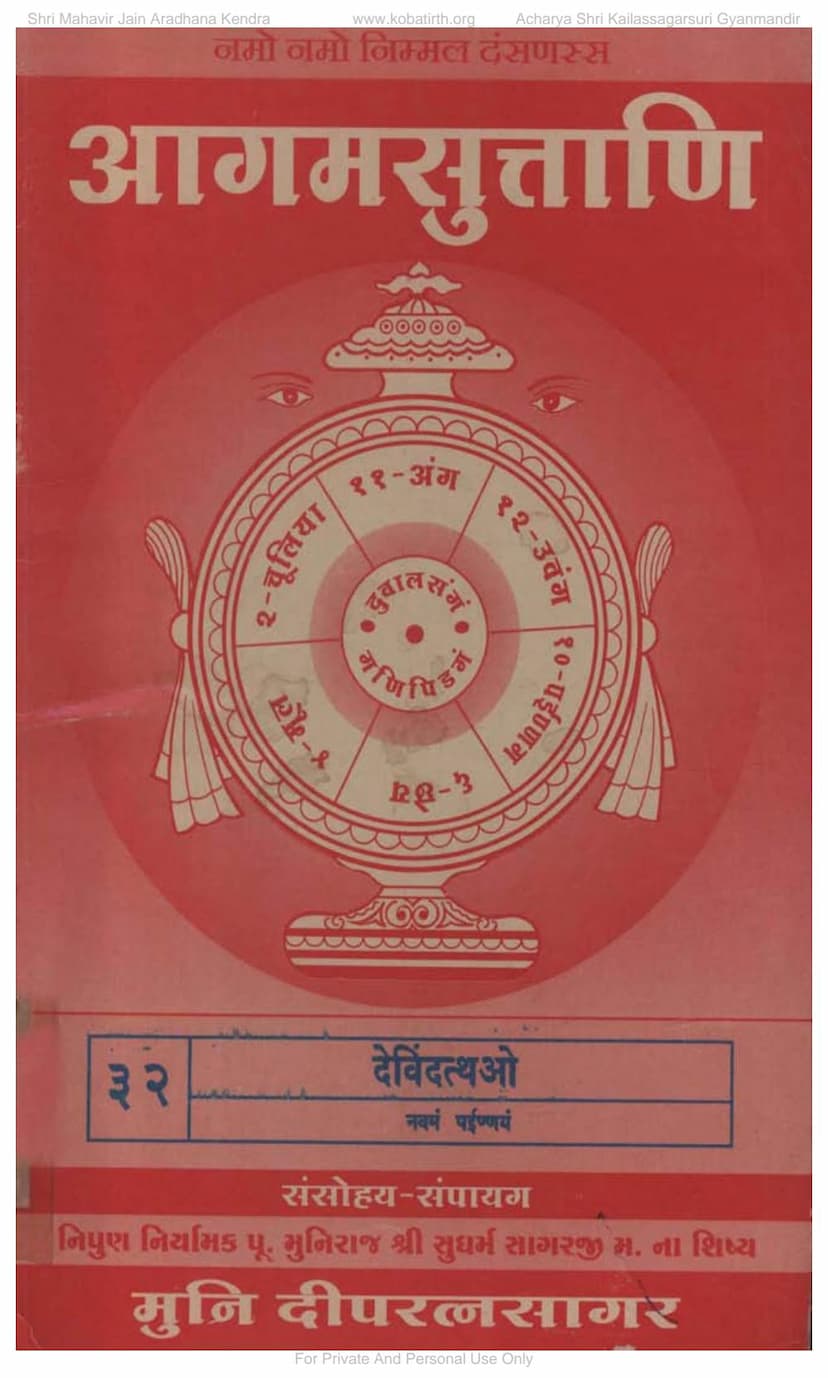Agam 32 Devindatthao Painnagsutt 09 Moolam
Added to library: September 1, 2025

Summary
This document is the 32nd Agam Sutta, specifically the 9th in the "Painna Sutta" section, titled "Devindatthao Moolam." It is part of a larger series of Agam Suttas published by Agam Shrut Prakashan.
The text itself is in Prakrit, a classical language of Jainism. It meticulously details the cosmology and hierarchy of the heavens and their celestial inhabitants, particularly focusing on the various classes of gods and their respective realms.
Here's a breakdown of the content, based on the provided pages:
Overall Scope:
- Title: Agam 32, Devindatthao Painnagsutt 09 Moolam
- Authorship: Dipratnasagar, Deepratnasagar
- Publisher: Agam Shrut Prakashan
- Purpose: To provide a detailed description of the heavens, their inhabitants, and their hierarchical structure within Jain cosmology.
Key Content Areas:
- Introduction and Invocation: The text begins with invocations to the Tirthankaras, particularly Mahavir Swami and Nemnath, and veneration of spiritual teachers.
- Description of Heavens (Devlok): The core of the text is dedicated to describing the various levels of heavens and the beings that reside in them. This includes:
- Bhavanavasi (Indwelling Gods): This category details the various types of gods who reside in palaces and cities. These are further categorized into:
- Asuras (Demons/Gods): Chamar, Vairochana, etc.
- Nagas (Serpent Gods): Dharana, Bhuyananda, etc.
- Suparnas (Bird-like beings): Suvarnindra, Venudeva, etc.
- Dipa Kumaras (Island-dwelling Gods): Putra, Vasishtha, etc.
- Udaka Kumaras (Water-dwelling Gods): Jalakanta, Jalaprame, etc.
- Vayu Kumaras (Wind-dwelling Gods): Velamba, Prabhanjana, etc.
- Dhanyas Kumars (Cloud-dwelling Gods): Ghosha, Mahaghosha, etc.
- Vidyut Kumars (Lightning-dwelling Gods): Harikanta, Harissaha, etc.
- Vanamantaras (Intermediate Gods): This section describes another class of celestial beings, often associated with forests and intermediate regions. It lists various types like Pisachas, Yakshas, Rakshasas, Kinnaras, etc., and their respective kings.
- Jyotishis (Luminous Beings): This category covers celestial bodies like the Sun, Moon, stars, and planets, describing their movements, formations, and the gods associated with them.
- Vaimanikas (Palace-dwelling Gods): This is a broad category that includes gods residing in celestial palaces. The text details:
- Kalpas (Realms): The text enumerates the different Kalpas (celestial realms) such as Saudharma, Ishana, Sanatkumara, Mahendra, Brahmaloka, Lantaka, Mahashukra, Sahasrara, Aanata, Pranaata, Aarana, and Achyuta.
- Devas (Gods) within each Kalpa: The specific number of gods and their respective lifespans, qualities, and residences within each Kalpa are described.
- Graiveyakas (Necklace-like Heavens): These are described in three tiers (lower, middle, upper), each with specific characteristics.
- Anuttaras (Supreme Heavens): These are the highest celestial realms, described as being free from suffering and possessing supreme bliss.
- Bhavanavasi (Indwelling Gods): This category details the various types of gods who reside in palaces and cities. These are further categorized into:
- Cosmic Dimensions and Geography: The text provides details about the dimensions of various celestial realms, the earth, and the distances between them. It also describes the appearance and construction of celestial palaces and cities.
- Characteristics of Celestial Beings: The text discusses the lifespans, senses, qualities, and the type of sustenance (food) for these celestial beings. It also touches upon their movements and perceptions.
- Siddhas (Liberated Souls): The latter part of the text shifts to describe the realm of the Siddhas, the liberated souls who reside at the apex of the universe. It details their nature, form, location, and the nature of their eternal bliss.
- Appendices (Parisishtha): The document includes appendices that list various indexes:
- Vishayanukramo (Subject Index): A comprehensive index of subjects covered in the Agamas.
- Vishishtha Shabd Anukrami (Specific Word Index): An index of specific words found in the Agamas, with their locations.
- Vishesh Nam Anukrami (Specific Name Index): An index of unique names mentioned in the Agamas.
- Gathanukrami (Verse Index): An index of verses (Gathas).
- Sutranukrami (Sutra Index): An index of Sutras.
Key Themes:
- Cosmic Hierarchy: The Jain understanding of the universe is presented as a meticulously organized system with different realms and classes of beings occupying specific positions.
- Divisions of Heaven: The detailed enumeration of the various heavens and their subdivisions highlights the complexity of Jain cosmology.
- Celestial Life: The text provides insights into the characteristics of gods, their lifespans, and their enjoyments.
- Path to Liberation: The description of the Siddhas at the end points towards the ultimate goal of Jain spiritual practice – liberation from the cycle of birth and death.
Publication Information:
- The document indicates the publisher as "Agam Shrut Prakashan" and mentions "Shri Mahavir Jain Aradhana Kendra" and "Acharya Shri Kailassagarsuri Gyanmandir" as associated entities.
- It also lists numerous individuals and families who provided financial assistance for the publication of the Agam set, demonstrating the collaborative effort involved in preserving and disseminating these Jain scriptures.
In essence, "Devindatthao Painnagsutt 09 Moolam" is a foundational Jain text that provides a detailed, cosmological map of the heavens, offering a glimpse into the Jain worldview of the universe and its celestial inhabitants, culminating in the description of the ultimate state of liberation.